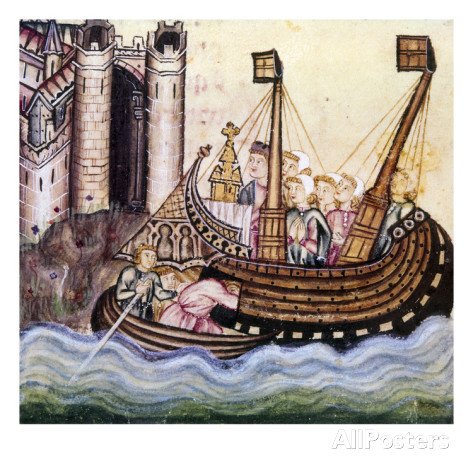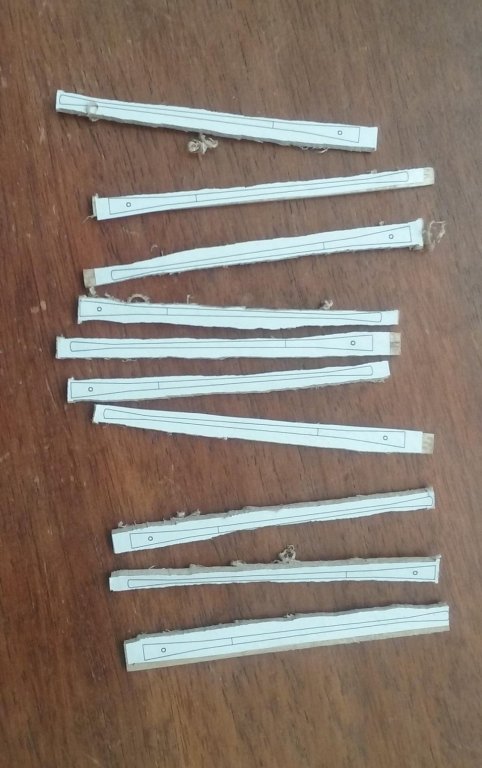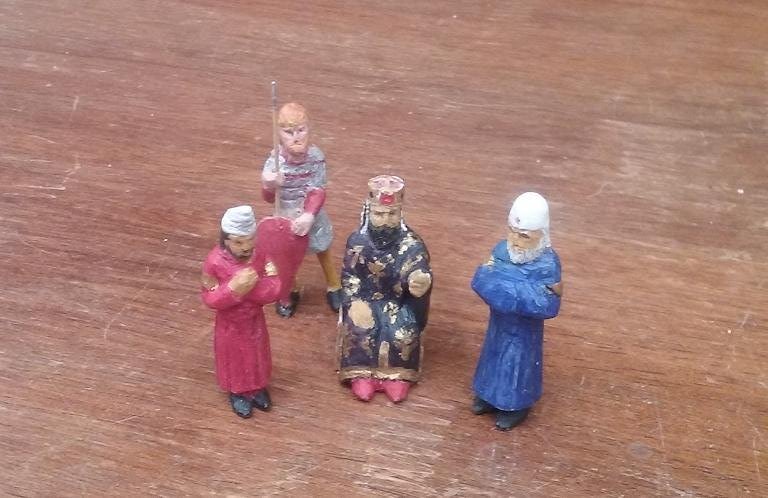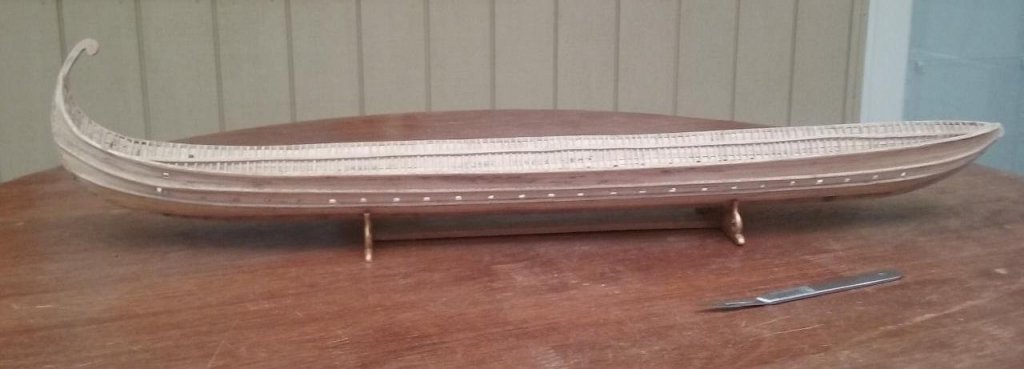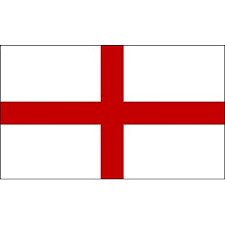-
Posts
7,975 -
Joined
-
Last visited
Content Type
Profiles
Forums
Gallery
Events
Everything posted by Louie da fly
-
This picture (also from the Cantigas) has more detail and may help decide what they are and how they're made. The masts are interesting, too. And this ship has a hatch in the side. My feeling is that these structures originated as protection for the steering oars (in case of collisions etc) - note that the "wings" still seem to be there - but may have evolved into something quite different. Steven
-
Very impressed with the way you made the gunport frames so they're all exactly the same, and avoiding the method of building with "sticks". And the way you installed them is brilliant, as well. So simple and obvious once you've seen it done, but first someone has to think of it . . . Steven
-
I believe the last picture shows the planked timber housings for steering oars - at least that's how I interpret them. I'm going to base the steering housings for my own build on this picture. The Cantigas ships aren't the only ones with weird structures at the stern. There are a plethora of weird and wonderful stern constructions on Mediterranean ships in and about the 13th century. Heaven only knows what they were, how they were built, or what they did . . . By the way, I have serious doubts about the "hulc" theory - the original proposition is based on a single representation on the seal of the town of Hulkesmouthe which describes as a "hulc" a ship with these funny curved planks, plus a couple of rather small vessels in the archaeological record which appear to be built of planks curved like a basket or a barrel, and could be interpreted as being the physical manifestation of the ship on the seal. (see http://www.machuproject.eu/machu_cms/VoC/VoC_Wreck_View.php?wreck_id=454&lang=EN for an example) But the hulk/hulc was an ocean-going vessel by all accounts (it apparently replaced the cog) and I seriously doubt if the ships discovered would have survived well at sea. It seems to me that the Cantigas ships, those on the seal, and several others I'm aware of (e.g. the ship carrying St Louis to his crusade) may simply be an attempt to represent planking such as is found on the Viking longships - which also curves up at bow and stern, but misinterpreting the structure itself (the artists wouldn't be nautical types and simply drew what they thought was there from a brief look at a bunch of ships in harbour). Not enough, in my view, to base a whole academic theory on. I just think the proponent of the "hulc" theory has leapt to a conclusion on far too little information - that the word hulc is used to describe the ship on the seal because of the planking shown - rather than (as I believe more likely) that it's simply being used as a generic word for "ship". Not that I know what a hulc/hulk actually was - perhaps it was the ship which appears in the early 15th century with the same hull shape as the carrack, but with only a single mast - a sort of proto-carrack? Perhaps a hulc wasn't a particular type of ship at all, just a word that came into use to describe ships in general.There's just far too little information out there. Steven
-
A very good project, Dick. A very interesting time for nautical design - I wish I could work out how the sterns of some of these ships worked, particularly the ones of the Cantigas of Santa Maria. I should perhaps clarify that I meant ships of the crusading period (generally 1096 to 1291, between the crusaders gaining and losing the Holy Land). I'd actually be surprised if there were such things as crusader ships - it's far more likely that the ships the crusaders travelled in were provided (at a good profit) by the Italian republics, particularly Genoa and Venice. Certainly this was the case with the Fourth Crusade, and I expect with many, if not all, of the others. Steven
-
Yes - for a relatively short period (a few decades) before they thought of piercing the sides for artillery. Though "railing pieces" (or swivel guns) stayed in use a lot longer (several were found on the Mary Rose and they were still in use as late as the Endeavour, which had a dozen of them), as far as I know they usually weren't mounted on the gunwales, as they'd get in the way of the bigger calibre guns. Steven
-
I agree with Druxey and Carl. There's a doctoral thesis in the TAMU records online which consists of a speculative computer reconstruction of a dromon which is certainly no better nor better researched than your own model. I think if you showed this to a knowledgeable nautical academic, he/she could not fail to be impressed with the breadth and depth of research you've undertaken in constructing this model - as I am. Of course, there's a good chance that the Black Sea discoveries will prove some of your conclusions incorrect. This is always the case in research, and doesn't invalidate your work in any way. I'm in the same boat (sorry!). One part of me is dreading the discovery of a complete dromon, with my own model only half completed. The other part of me is looking forward to it with great excitement. Steven PS: I think this era is exactly the time to be calling them gunwales - this is when they first attached guns to the upper wale, so what could be more appropriate?
-
We'd probably say "freehand". It's looking very good, Patrick.
- 756 replies
-
- galleon
- golden hind
-
(and 2 more)
Tagged with:
-
Yes, and he's about a head taller than everyone else - the Arab chronicler Ibn Fadlan described them as "tall as date palms". Steven
-
* Fixed now. All photos the right way up. Sorry for any neck injuries as people craned to see them. Steven
-
I haven't updated the log for a while - camera problems meant I couldn't post photos - but I haven't been totally idle. I've cut out all the oarports - the photo was taken yesterday and shows it with a few still to go. Very fiddly trying to get them all the same with the tools I have. And I've made a start on the lower deck oars - here are the first set of blanks I've cut out. The "business" end is as usual, but the handle end won't be visible and I'm experimenting with a shape that can be pinned to the "oarframe" (see photo from two posts ago) and will swivel easily when attached, so I can get the angle of the oars right before I glue it in its final configuration. I don't know why the photos are in the wrong orientation - they were ok when I was working on them. * I've added a beam shelf each side to support the deck beams when the time comes, and I've also added a couple of crossbeams to support the oarframe. And I've completed Emperor Alexios, two of his courtiers and one of his Varangian Guardsmen (I may or may not make a second one - depends on the space available on the poop deck). Next on the list will be making and fitting the mast step(s) and re-fitting the "wings" for the rudders.
-
I thought that was Treebeard . . . Steven PS: Looks like a very nice project to undertake. Good looking boat.
-
Another thought - perhaps the line they followed is a "Great Circle" - a curve joining the ends of a diameter of the Earth - that is the shortest route over the surface f a sphere. I don't have the math to work this out, but it may be a possibility.
-
Two thoughts occur - Both ships may have been staying well clear the coast until they reached the right latitude and then sailed east along the parallel until they reached the coast. Unless I was totally certain of the accuracy of my chronometer I'd be treating the longitudinal calculations not as totally reliable but "more of a set of goideloines". I wouldn't risk the safety of the ship on them unless I had to. The other thing is the prevailing winds. If they are westerly, the coast becomes a lee shore - much to be avoided. Even if they only got occasional westerlies, I'd be staying well away from the coast if possible until it was time to go into port. Steven
-
The cross of St George relates specifically to England - a red cross on a white background. The "Union Jack" - the flag of Great Britain - is a combination of the Cross of St George (England), with Scotland's cross of St Andrew - white saltire (diagonal cross) on a dark blue background and Ireland's Cross of St Patrick (red saltire on a white background) Steven
-
Thanks, Dick. I was originally thinking of getting an old cotton sheet from an op shop, sufficiently worn to be thin enough to make a sail at 1:50. But silkspan might be a better option. Fortunately I have plenty of time to think about it. There's plenty to do to the ship before it becomes an issue. And yes, I think I get what you mean about the bulging. I wish you every success with your cunning plan for the half deck. Looking forward to seeing it when it's done. Steven
-
On further consideration I should also say that there'll be no permanent harm done by loosening off the clamps - you'll just have the sides spring outwards, which can be remedied as above. But before you do, make the temporary clamps so you can push the hull back into shape when it's time to glue in the stringer and the beam shelf. It's best to make them while the hull is still being held "shipshape" so you have a shape to return to. Do as many as you need to, probably at fairly close intervals, and ensure the hull and the clamps are marked to show where each one goes, as the distance apart of the bits of bamboo skewer varies depending on the shape of the hull. Good luck with it. Steven
- 8 replies
-
- deformation
- ribs
-
(and 1 more)
Tagged with:
-
I would advise against taking off all the reinforcements and hoping it will sort itself out. It won't. I had a similar problem - my dromon had bentwood frames which spread outward when I took it off the plug. My idea was to use crossbeams to hold the sides in, but I also had a lot of work to do inside the hull before I could glue the crossbeams in place. So I made some temporary "clamps" out of popsicle sticks and bamboo skewers, rather like your braces, to hold the hull shape while I worked on the rest (see page 9 of my build log - posts from Aug 27 to Sept 7 of 2017). Each clamp was sized to sit in one particular place on the hull (and marked accordingly). The beauty of these things is they are so easy to put on and take off. Your problem is more difficult but I believe putting in more temporary clamps would help a lot. You can take off one clamp at a time to work inside the hull without the hull deforming too much (particularly if you work fairly fast!). And adding the stringer and especially the beam shelf should solve the problem permanently. Steven
- 8 replies
-
- deformation
- ribs
-
(and 1 more)
Tagged with:
-
Maritime figures are a bit thin on the ground in Oz, but it might be possible to "bash" wargaming or model railway figures to look right for your purpose. It would also depend on the period you're portraying. Your 22mm figures would be about 1:83 scale. Railway figures in HO scale (3.5mm=1 foot=1:87) would be just over 21mm tall for a person 6-feet tall, though as I recall, most figures are what they call OO/HO, which is 4mm to the foot (=1:76) so a 6-footer would be be 24mm high. Then there are military figures at 1:72 scale (about 24mm high). But I did find this link https://www.1001modelkits.com/small-scale-soldiers/16329-hat-industrie-hat8098-british-sailors-and-marines-x-80-figures-and-8-naval-cannons-0696957080983.html?iPage=1 and I'm sure there are others out there if you're prepared to look overseas. Steven
-
Dick, I got it from Pinterest, a source that is both valuable and occasionally extremely frustrating for its lack of attributions. It is ascribed to Gregorio Dati, a Florentine merchant and diarist who lived from 1363 to 1436, (wikipedia entry at https://en.wikipedia.org/wiki/Gregorio_Dati ) and is apparently held in the New York Public Library, Spencer Collection MS MA 110. It is only vaguely dated (c.1400, which seems to be definitely too early). It could be an illustration from one of his books, but seems definitely later than when they were written. Regarding the strange "stunsails", the have me flummoxed. A very pretty picture, but I have no idea what connection it has with reality. There are several navi tonde (I think that's the plural) with only a single extra mast - the Reixach carrack has a mizzen but no foremast and the picture with the blue tent (above) and the picture immediately above it both show carracks with a foremast but no mizzen. I think you're right to do the mizzen at the very least. As far as I can recall, you built the upper works on the assumption that they'd have to make room for a mizzen mast. It's a beautiful build, I'm really looking forward to seeing her complete. Steven
About us
Modelshipworld - Advancing Ship Modeling through Research
SSL Secured
Your security is important for us so this Website is SSL-Secured
NRG Mailing Address
Nautical Research Guild
237 South Lincoln Street
Westmont IL, 60559-1917
Model Ship World ® and the MSW logo are Registered Trademarks, and belong to the Nautical Research Guild (United States Patent and Trademark Office: No. 6,929,264 & No. 6,929,274, registered Dec. 20, 2022)
Helpful Links
About the NRG
If you enjoy building ship models that are historically accurate as well as beautiful, then The Nautical Research Guild (NRG) is just right for you.
The Guild is a non-profit educational organization whose mission is to “Advance Ship Modeling Through Research”. We provide support to our members in their efforts to raise the quality of their model ships.
The Nautical Research Guild has published our world-renowned quarterly magazine, The Nautical Research Journal, since 1955. The pages of the Journal are full of articles by accomplished ship modelers who show you how they create those exquisite details on their models, and by maritime historians who show you the correct details to build. The Journal is available in both print and digital editions. Go to the NRG web site (www.thenrg.org) to download a complimentary digital copy of the Journal. The NRG also publishes plan sets, books and compilations of back issues of the Journal and the former Ships in Scale and Model Ship Builder magazines.



